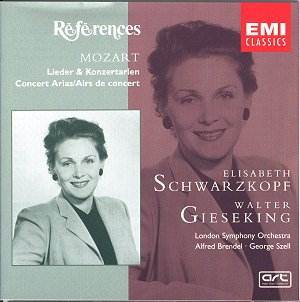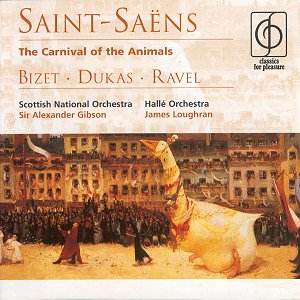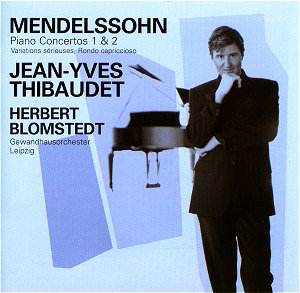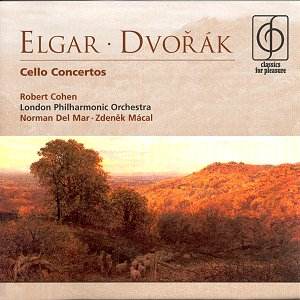 Composer: Wolfgang Amadeus Mozart
Composer: Wolfgang Amadeus Mozart
Works: Ridente la calma, K. 152; Oiseaux, si tous les ans, K. 307; Dans un bois solitaire, K. 308; Die kleine Spinnerin, K. 531; Als Luise die Briefe, K. 520; Abendempfindung, K. 523; Das Kinderspiel, K. 598; Die Alte, K. 517; Das Traumbild, K. 530; Das Veilchen, K. 476; Der Zauberer, K. 472; Im Frühlingsanfang, K. 597; Das Lied der Trennung, K. 519; Die Zufriedenheit, K. 349; An Chloe, K. 524; Sehnsucht nach dem Frühling, K. 596; Ch’io mi scordi di te?, K. 505; Vado, ma dove?, K. 583; Alma grande e nobil core, K. 578; Nehmt meinen Dank, K. 383
Performers: Elisabeth Schwarzkopf (soprano), Walter Gieseking (pianoforte), Elisabeth Schwarzkopf (soprano), Alfred Brendel (pianoforte), London Symphony Orchestra/George Szell
Recording: Recorded 13, 14, 16 April 1955; 10, 11, 14, 18 September 1968, Kingsway Hall, London
Label: EMI CLASSICS CDZ 5 74803 2
Mozart’s vocal works, particularly his lieder and concert arias, stand at a fascinating juncture in the evolution of vocal music, straddling the transition from the Baroque to the Classical era and foreshadowing the Romantic spirit that would be fully realized by Schubert. The present recording showcases a selection of these works through the artistry of Elisabeth Schwarzkopf and her collaborators, Walter Gieseking and George Szell. The juxtaposition of the earlier chamber works with the orchestral settings of the later arias offers a compelling exploration of Mozart’s diverse compositional voice.
Schwarzkopf’s interpretations of these lieder are marked by her remarkable control and expressive nuance, attributes that were particularly pronounced in her prime. In the earlier recordings with Gieseking, such as “Das Veilchen” and “Abendempfindung,” her vocal timbre, still fresh and unblemished by time, radiates a clarity that belies the simplicity of the piano accompaniments. Gieseking’s pianism is equally notable; his ability to evoke a rich palette of colors without resorting to the sustaining pedal is nothing short of masterful. This technique allows the listener to appreciate the intricate counterpoint of Mozart’s writing, transforming ostensibly straightforward strophic forms into vivid, intimate dialogues between voice and piano.
In contrast, the later recordings with Szell, while undeniably rich and full, present a different interpretation. Schwarzkopf’s voice has matured, gaining a roundness and warmth that enhances the lyrical beauty of arias like “Vado, ma dove?” However, Szell’s conducting, while precise, occasionally weighs down the proceedings, lacking the buoyancy one might hope for in such spirited works. The vitality found in her earlier performances can be overshadowed by a more lethargic approach in these later sessions, making comparisons inevitable. The stark difference in energy levels between Szell’s interpretations and those of her previous collaborators illustrates how interpretative choices can significantly alter the listener’s experience.
The sound quality and engineering merit mention as well. The remastering of these recordings has succeeded in preserving the rich textures of both voice and accompaniment, allowing Schwarzkopf’s nuanced phrasing and Gieseking’s delicate touch to emerge with remarkable clarity. The balance between voice and piano is meticulously crafted, ensuring that neither overpowers the other, a crucial aspect in the interpretation of these intimate works. Additionally, the inclusion of texts and translations serves to enhance the listener’s engagement with the material, providing context that deepens appreciation for the emotional landscapes that Mozart so deftly constructs.
Schwarzkopf’s ability to imbue her performances with a personal touch—her inflection of lines such as “zeigen” in “Das Lied der Trennung” or the subtle variations in tone across the strophic forms—demonstrates why she remains a towering figure in the world of vocal music. The artistry displayed in her interpretations, particularly in her capacity to navigate the emotional subtleties of Mozart’s music, speaks volumes of her deep understanding of the repertoire.
This collection, with its blend of historical significance and vocal artistry, offers both an introduction to Mozart’s lieder and a reaffirmation of Schwarzkopf’s enduring legacy. The performances capture not just the notes on the page but the spirit of the era, making this recording an essential addition to any classical music enthusiast’s library.



